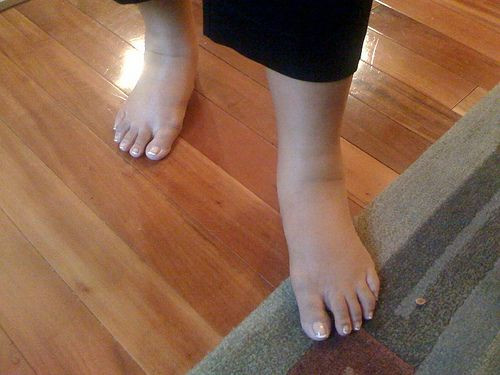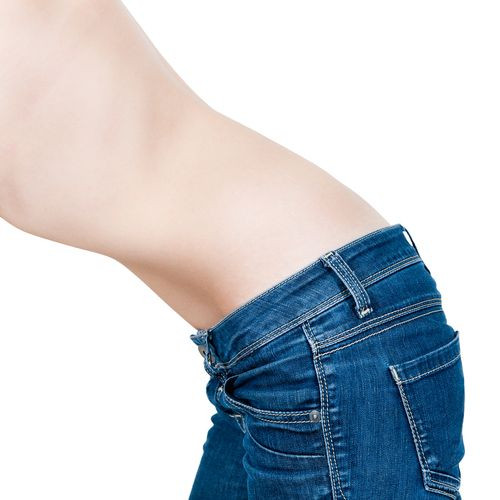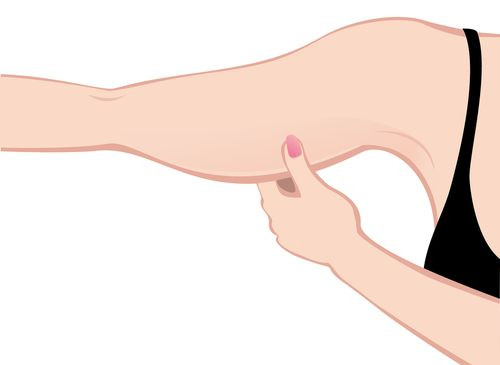Do You Really Need To Get Rid Of Your ‘Thut’? Plus 4 Other 'Body Parts' That Only Kind Of Exist

No one is simply fat or skinny anymore — perhaps for good reason. The overly simple dichotomy leaves out a raft of conditions related to obesity and eating disorders, which never would have arisen if not for an attuned focus on health rather than image. But sometimes we humans take the labeling too far, putting undue pressure on ourselves because we don’t look a certain way. Including the latest trend of getting rid of your “thut,” here are five body parts that people mostly made up (and which probably only serve to make us more insecure about our bodies).
5. Cankles
Working our way up from the bottom, we have the high-heel-wearer’s nightmare, the shapeless and tubular condition of a person’s calf seamlessly forming into an ankle. Cankles are perhaps the most common of the anatomical portmanteaus, and while they aren’t recognized as legitimate medical conditions or concerns themselves, they are associated with other, more serious ailments.

"Things like diabetes, hypertension, cardiovascular risks, sometimes just lymphedema," Dr. Kathya Zinszer, a physician at Temple University's School of Podiatric Medicine, told CNN. "All of those can lend themselves to deformed ankles or what people are [calling] cankles."
If the transition from your lower leg to your foot looks more like a fleshy log than a delicate, tapering calf, it could indicate increased swelling in the ankle region. This may be the result of too much sodium in one’s diet or a hormonal imbalance. Or, if you know your cankles are simply a result of genetics, consider the $6,000 liposuction procedure to have the surrounding fat removed in a matter of minutes.
4. Thut
Moving up the leg, we arrive at the newly designated thut. A perhaps friendlier-sounding hybrid of two (real) body parts — the thigh and the butt — compared to the cankle, you can think of the thut as the cankle of the North. Like the cankle, its hallmark is uniformity. A person with a thut has no discernable rounding to indicate where the thigh ends and the butt begins. (See also: “pancake butt.”)

But thuts differ from cankles in their physical make-up. Where cankles reflect an overabundance of fatty tissue around the ankle joint, a thut is characterized by underdeveloped glute and hamstring muscles. Their deficiency is entirely aesthetic. A result of prolonged sitting, the thut is perhaps most common among office workers, who rely on a flat, fatty upper thigh area as a primary source of cushioning. Experts say the condition (if it can even be called such a thing) arises purely from lack of exercise.
While a person’s genetic makeup may influence how quickly or slowly the muscle tissue responds to that exercise is a different story. “But mostly this is a problem of tone and proper use,” Valerie Samulski, the pilates coordinator for YogaWorks in New York told the Daily Mail. Ultimately, however, the presence of a thut could lead to postural problems, as an elevated rear end helps the spine sit more naturally. “It should be toned because it helps you stand properly,” Samulski said.
3. Front Butt
As the United States moves deeper into its obesity epidemic — 35.7 percent of all adults are now obese, according to the Centers for Disease Control and Prevention — what once sufficed as a muffin top has now descended beneath the waistline. They’re known, lovingly, as front butts. And they refer to the collection of loose skin and fat sitting beneath a person’s navel. Generally, they arise for one of two reasons: obesity and recent weight loss.

Obesity may be the most recognizable condition that precedes, or accompanies, a front butt. Unlike cankles or thuts, however, “front butt” is actually the slang term for a real condition, called a panniculus, which follows many pregnancies and other cases of sudden, extreme weight loss where a person’s skin has become so stretched out that it can’t retighten around a thinner frame. The tissue sags as a result.
The procedure to remove this excess fat and skin is called a panniculectomy. Experts are quick to point out the surgery isn’t meant to treat obesity or stand in place of proper diet or exercise. In the event a patient wants to improve his or her appearance through surgery, “alternative procedures may include liposuction, or an abdominoplasty,” which are two alternative procedures that can also reduce the hanging skin in the abdominal area, according to the University of Michigan Department of Surgery.
2. Bingo Wings
Four thousand percent. That’s how much the number of arm lift surgeries has increased by since the year 2000, according to the American Society of Plastic Surgeons (ASPS). While some who go under the knife do it purely to conceal signs of aging or weight gain, others face the same woes of panniculectomy patients. Often, rapid weight loss leaves people’s bodies with more skin than it needs. And the only way to tighten it is to cinch it manually.
But bingo wings have a particular flair to them. Drawing its name from the characteristic flapping motion of winning bingo ladies as they shout the namesake cry, bingo wings appear most often in the elderly and the obese. The elderly may not have much incentive to remove the unwanted “appendage,” but for formerly obese people, the typical diet-and-exercise route may not necessarily be a viable one.

“There is no amount of diet or exercise,” that can remove a bingo wing, Dr. Rod Rohrich, plastic surgeon at the University of Texas Southwestern Medical Center, told Nightcap TV. “We live on planet earth and gravity and even with weight loss and weight gain there is no way you can do this non-surgically.”
1. Man Boobs (“Moobs”)
Up there with thut, “man boobs” is among the most recent terms to emerge in the mainstream landscape. Despite its sophomoric status, the actual medical condition, called gynecomastia, arises from abnormally high levels of estrogen in men, coupled with low levels of testosterone. Gynecomastia has been implicated as a side-effect of everything from marijuana smoking, because of the plant’s THC content, to kidney and liver failure.
It’s also been found to result from metabolic disorders, Klinefelter’s syndrome (a condition where males have an extra X chromosome), and the general loss of testosterone through aging. Fortunately for men who wish to rid themselves of the condition, which, like thut and cankles, is mostly aesthetic, because it’s excess fat, targeted diet and exercise generally alleviate the issue.

One ASPS study found living with gynecomastia significantly hurts adolescent males’ self-esteem, eating habits, and other areas of their mental and physical health. Given the fickle nature of the condition, as it may be rooted in both fitness and glandular deficiencies, researchers urge men to look into treatment options as early as possible.
"Merely having gynecomastia was sufficient to cause significant deficits in general health, social functioning, mental health, self-esteem, and eating behaviors and attitudes compared with controls," researcher Dr. Brian Labow and co-authors wrote. "As a result, early intervention and treatment for gynecomastia may be necessary to improve the negative physical and emotional symptoms.”



























